Tag archives: LHC
Physics World 2014 Focus on Big Science is out now
By Michael Banks
This year has been a special one for the CERN particle-physics lab near Geneva as it turns 60 years old. It was back in 1954 when the CERN convention was ratified by its first 12 member states and the European Organization for Nuclear Research was officially established.
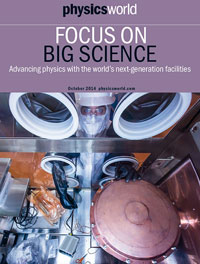 The past few months have seen CERN celebrate in style with a whole host of symposia, meetings, plays, films, concerts and other events being held at the lab and at member states across Europe.
The past few months have seen CERN celebrate in style with a whole host of symposia, meetings, plays, films, concerts and other events being held at the lab and at member states across Europe.
Indeed, researchers at CERN have had a lot to celebrate recently, following the discovery of the Higgs boson at the lab in 2012, and they will be hoping for yet more success when the Large Hadron Collider (LHC) switches on next year following a two-year upgrade and maintenance programme.
In the latest Physics World focus issue on “big science” we look at what has been going on at CERN during the shutdown as the lab gears up to hunt new particles beyond the Higgs boson. Once back online, the LHC will be generating even more data than in its previous run and this focus issue also investigates how researchers are going to deal with the huge volumes of information that will be generated at many upcoming facilities, as well the need to train the next generation of researchers to use them.
View all posts by this author | View this author's profile
A scientific pyramid scheme, symmetry through the ages, why physics students are “standing a little taller” and more
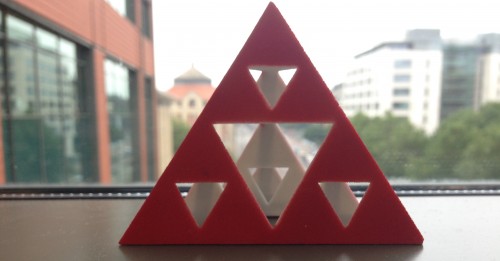
Pyramid power: this lovely object has nothing to do with postdocs. It is a simpler version of a much larger Sierpinski tree that can be found on London’s South Bank.
By Hamish Johnston
Just this week six people were convicted in Bristol of crimes related to running a pyramid scheme. This involves taking money from lots of new investors and giving it to a smaller number of investors who signed up earlier – until the pyramid collapses. Is the current model for training scientists a pyramid scheme of sorts? That is the claim in a piece on the US’s National Public Radio (NPR) website written by Richard Harris.
View all posts by this author | View this author's profile
Is desperation for new physics clouding our vision for new colliders?
By Hamish Johnston
This month marks the 60th anniversary of CERN and to kick-off our coverage here at physicsworld.com, I’m highlighting an essay on the future of collider physics that has just been written by Nobel laureate Burton Richter called “High energy colliding beams; what is their future?“.
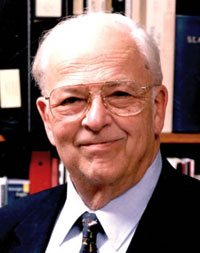
Burton Richter warns against desperation. (Courtesy: Stanford University)
Richter shared his 1976 Nobel prize with Samuel Ting for their independent discoveries of the J/ψ meson. He knows his particle colliders, having helped to design and build the world’s first collider in the late 1950s at Stanford University and later directing the Stanford Linear Accelerator Center for 15 years.
Richter believes that the international community is not facing up to tough decisions that must be made about what to do when the Large Hadron Collider (LHC) is retired sometime in the early 2030s. He thinks that “the perspective of one of the old guys might be useful”.
Planning the next huge collider involves the co-operation of three main groups of physicists: those who design and build the accelerators; those who design and build the experiments; and the theoretical physicists who work out what the experiments are looking for. Richter thinks that this is not going well at the moment.
View all posts by this author | View this author's profile
Rebirth of the SSC?

Physicists entering the derelict site of the Superconducting Super Collider in 2011.
By Michael Banks
Following the closure of Fermilab’s 1 TeV Tevatron particle collider near Chicago in 2011 – and with no similar facility being planned to replace it in the US – many physicists in the country felt not surprisingly concerned that America was losing its place at the “energy frontier”. That baton had already passed to the CERN particle-physics lab near Geneva when its Large Hadron Collider (LHC) fired up in 2008, and with collisions set to restart there next year at 13 TeV, the US’s day looked certain to have passed.
View all posts by this author | View this author's profile
Join CERN’s scavenger hunt
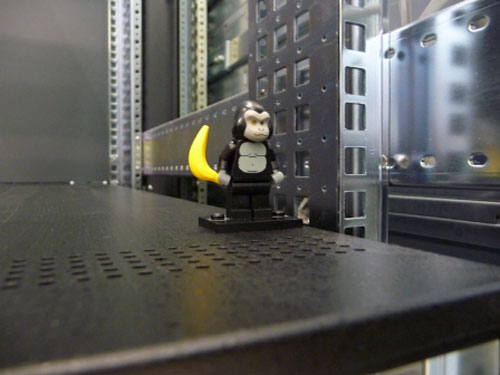
Can you spot all 20 or so LEGO figurines in the CERN computing centre?
By Michael Banks
You may remember that late last year CERN teamed up with Google Street View to allow users to go on a virtual tour of the lab, including 12 km of the 27 km Large Hadron Collider (LHC) tunnel plus the caverns that house the ATLAS, CMS, LHCb and ALICE experiments.
This involved Google‘s Zurich team spending two weeks at CERN in 2011 photographing the LHC using a “Street View Trike” – a specially created camera-mounted bike.
Well, what we didn’t known then was that Stefan Lüders, CERN’s computer security officer, had decided to stash about 20 LEGO figurines around the CERN computing centre before the cameras rolled.
View all posts by this author | View this author's profile
Physics World 2013 Focus on Big Science is out now
By Michael Banks

Physics World Focus on Big Science.
All eyes will be on Stockholm next week as the 2013 Nobel Prize for Physics is announced. One of the frontrunners for the prize in the minds of the Royal Swedish Academy of Sciences will surely be the discovery last year of the Higgs boson at CERN’s Large Hadron Collider (LHC).
But the LHC story is far from over and in the latest Physics World focus issue on “big science” find out how the LHC will hunt for new particles beyond the Higgs boson once the collider restarts in 2015 following an 18-month repair and upgrade programme at the Geneva-based lab.
All full members of the Institute of Physics will receive a print edition of the focus issue along with their copy of the October issue of Physics World, but everyone can access a free digital edition. The focus issue also looks at how particle physicists are already thinking about what could come after the LHC, with bold plans for a 80–100 km proton–proton collider. There are even plans for a collider based on lasers, with an international team looking at creating an array of “fibre lasers” to be used as a future “Higgs factory”.
LHCb and CMS see rare decay of the strange B meson

A strange B meson decay event as seen by CMS. (Courtesy: CERN)
By Hamish Johnston
It’s a story with a hint of both “man bites dog” and “dog bites man” about it.
Physicists working on the CMS and LHCb experiments at CERN have independently seen an incredibly rare decay of a particle – a strange B meson decaying into two muons. The odds of this meson decaying in this particular way is about one in a billion, making the joint discovery a triumph of experimental particle physics. And it is officially a discovery. That’s because when data from the two experiments are combined the observation has a statistical significance of greater than 5σ, which is the gold standard in particle physics.
View all posts by this author | View this author's profile
Explaining CERN, the Higgs and the LHC
By Matin Durrani
How well would you do if someone asked you to explain the Higgs boson or the Large Hadron Collider (LHC) at CERN?
If you’re a physicist, you’ll probably find it hard enough. But if you’ve never done any physics in your life, things must surely be trickier still, more so if a film crew from Physics World has shoved a camera up your nose.
These two short videos show the results of a straw poll of randomly selected visitors at last summer’s Bristol International Balloon Fiesta when we asked them to describe the Higgs boson and the LHC.
The reason we were at the fiesta is that we were making a separate film about a project by Bristol University physicist Dave Cussans where school students were measuring cosmic rays during a hot-air balloon flight – it being the centenary of Victor Hess’s discovery of these rays in a balloon flight in central Europe.
View all posts by this author | View this author's profile
CERN teams up with EUROVISION to inspire the next Peter Higgs
By James Dacey

CERN is seeking to inspire tweens in science. (Courtesy: iStockphoto)
I must confess that I was not aware of this partnership, and I must admit it’s not a partnership I would have seen coming. CERN has teamed up with the organization behind the Eurovision Song Contest, in awarding grants to two multimedia companies to develop content that can spark the scientific curiosity of “tweens”.
Okay, let’s back up a second and define a few terms in this equation. Tweens are described by CERN as children aged 8 to 12; not quite teenagers but no longer big babies either. My teacher friends will shoot me down in flames for this cod-pedology but I guess this age group is old enough to be excited by science but not yet old enough to start truly engaging with scientific concepts.
View all posts by this author | View this author's profile
Magnet matters at the LHC
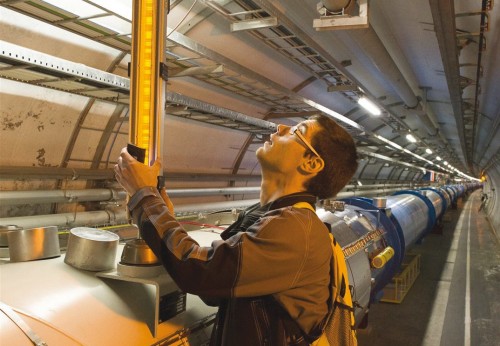
Hard at work at the LHC (Courtesy: CERN/Samuel Morier-Genoud)
By Hamish Johnston
Recently I had the pleasure of speaking to CERN’s Steve Myers who is supervising the herculean task of upgrading the superconducting magnets that guide protons around the Large Hadron Collider (LHC).
View all posts by this author | View this author's profile